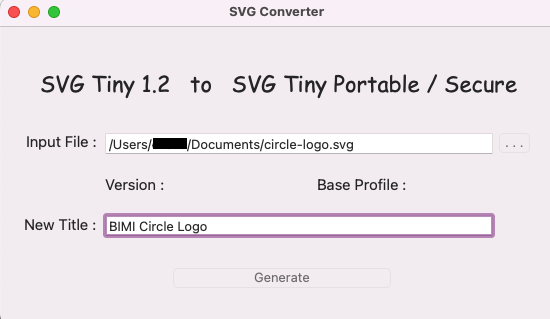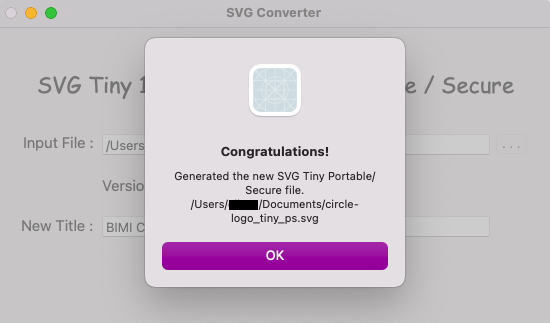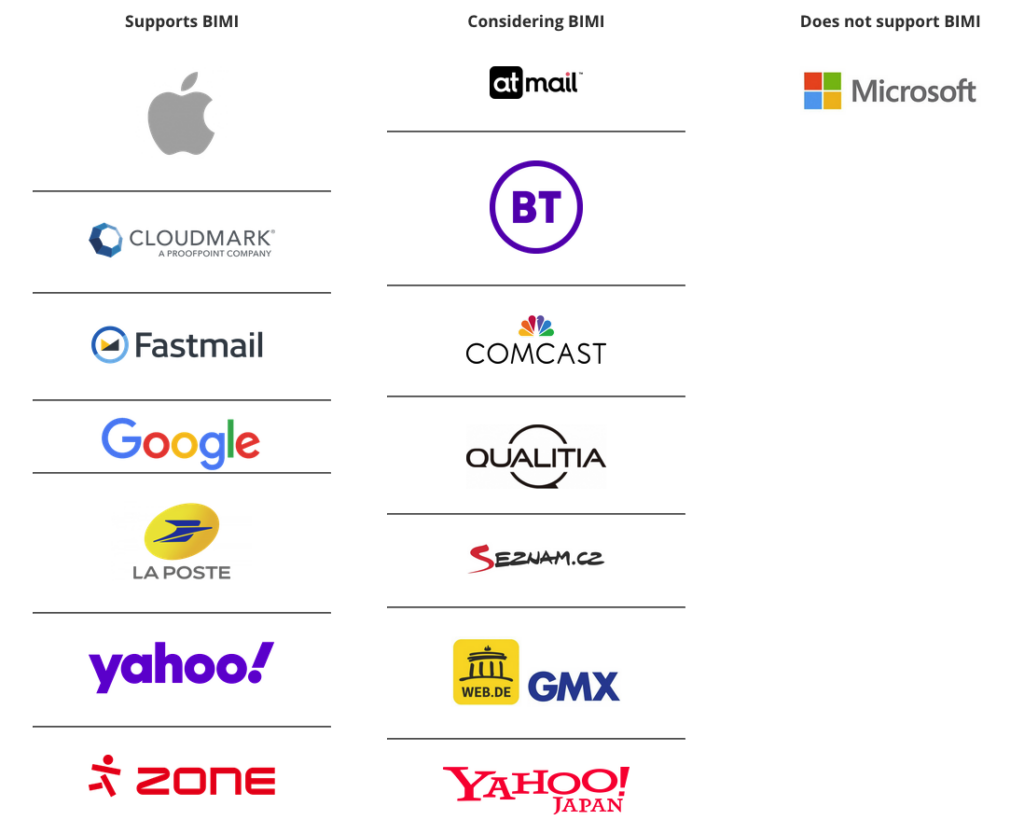- Guide
BIMI Logo: Tutorial & Examples
BIMI (Brand Indicators For Message Identification) is an emerging protocol for email that presents your branded logo next to your company’s emails in inboxes. The BIMI standard has specific logo requirements that restrict a logo’s file size and type.

Additionally, the BIMI ecosystem has rules about making your logo available so platforms can display it in inboxes. You have to host the file on a web server and create a particular DNS record that points to the URL where the file is hosted.
In this article, we review the rules for BIMI logos. Additionally, we’ll give you step-by-step instructions for creating a BIMI logo, and provide you with tips and best practices for deploying your BIMI logo successfully.
Summary of key BIMI logo concepts
The table below summarizes the BIMI logo concepts we will explain in this article.
| Concept | Description |
|---|---|
| BIMI logo requirements | BIMI logos must be SVG P/S files that are 32 KB or smaller and accessible via HTTPS. Brands must also verify trademark ownership |
| How to set up a BIMI logo | To set up a BIMI logo, you must first create the image file, then make it BIMI-ready. |
| BIMI logo best practices | Best practices such as verifying your BIMI deployment help improve email campaign effectiveness. |
BIMI logo requirements
You cannot use any arbitrary image file as a BIMI logo. The BIMI specification mandates that the file meets specific criteria and is accessible in a certain way. The table below summarizes the basic requirements for making a logo image file compatible with BIMI.
| Requirement | Explanation |
|---|---|
| Scalable Vector Graphics | BIMI logos use their own custom version of SVG called SVG Tiny Portable/Secure (SVG P/S). |
| Size limit | The file size must be less than 32 KB. |
| HTTPS | The logo file must be accessible via HTTPS. |
| Trademark ownership | You must verify that you are the legitimate proprietor of the branded logo. |
You can get up-to-date news and announcements about BIMI logo requirements on the BIMI Group’s website.
How to set up a BIMI logo
Creating an SVG image file containing your logo is a requirement for BIMI. However, you cannot just use any SVG file – you must comply with the size and file formatting restrictions mentioned in the table above.
Luckily, the BIMI group has published easy-to-use tools to convert a typical SVG file into a BIMI-compatible file. This section will walk you through the steps to create a BIMI-compatible image file.
Making an image file BIMI-ready
BIMI logos use a specific version of SVG called SVG Tiny Portable/Secure (SVG P/S). So even if you have an SVG, you’ll need to make some changes before your logo is BIMI-ready. Luckily, the BIMI Group has published some software tools that automate this process. The tool is available for MacOS, Windows, and as an Adobe Illustrator Export Script.
You can find the conversion toolset on the BIMI Group’s website. Let’s load our previous SVG file using this tool.

After adding the file and creating a title, click the “Generate” button.

This converts our original SVG file into a BIMI-compatible SVG P/S file. Let’s see how the content of the output file looks.
$ cat circle-logo_tiny_ps.svg
<?xml version="1.0" encoding="UTF-8"?>
<svg width="100" height="100" version="1.2" baseProfile="tiny-ps">
<title>BIMI Circle Logo</title>
<circle cx="50" cy="50" r="40" stroke="black" stroke-width="35">
</circle>
Sorry, your client does not support SVG.
</svg>
The tool has provided us with a file ready to use as a BIMI logo. If you want to understand how the tool works or need to verify the code, you can access it at this GitHub repository.
BIMI logo best practices
The instructions above give you the basics of creating a BIMI logo, but making a BIMI logo appear in inboxes involves more than merely creating a compliant logo image file. This section will provide tips for integrating your BIMI logo with the rest of your BIMI setup.
First, only send mail to people who want it
If your emails don’t reach the inbox, it doesn’t matter if you’ve got a logo, a VMC, and a DNS record referencing them. Thus, it’s of primary importance that you practice mailing best practices to increase the delivery rate of your mail. Let’s explore some basics of how you can
- Maintain a clean email list: Regularly clean your email list to remove invalid or inactive email addresses. This helps ensure that your emails are only delivered to active and engaged recipients, which can improve your overall deliverability.
- Authenticate your domain: Set up Domain-based Message Authentication, Reporting & Conformance (DMARC) records, which help prevent your emails from being marked as spam by verifying that they are actually sent from your domain. DMARC is also a requirement for BIMI.
- Use a reputable email service provider: Choose an email service provider (ESP) that has a good reputation for email deliverability and uses practices that are in line with industry standards. A reputable ESP can help ensure that your emails reach the inbox and are not filtered as spam.
Host your BIMI logo securely
When your BIMI logo loads in a recipient’s inbox, the platform acquires your logo by looking at the URL that your BIMI record points to with the “l” tag. You can learn more about that with our BIMI Record article.
This means that your BIMI logo needs to be web-accessible, that way the BIMI record has a URL to point to. Additionally, BIMI mandates that the logo be served via HTTPS. This mitigates the risk of a man-in-the-middle attack which would manipulate the image. The good news is that the TLS certificate required to enable HTTPS is available free from Let’s Encrypt.
You can learn more in the Let’s Encrypt Getting Started article.
Verify ownership of the logo
A significant part of the value of BIMI is that an authorized certificate authority verifies the logo. The process requires brands to acquire a Verified Mark Certificate (VMC). Obtaining a VMC is not a trivial process, and may require you to take steps such as:
- Paying as much as $1,499 USD
- Verifying your identity
- Proving ownership of the trademark
If you do not wish to go through this process, you can create a “self-asserted” BIMI record by leaving the “a” tag blank. However, acquiring a VMC will ensure that you are eligible for logo display at all mailbox providers that support BIMI, assuming you meet their other requirements for logo display.
As an emerging protocol, BIMI is evolving quickly. You can find updated information about VMC’s on the BIMI Group’s website.
Create a BIMI record
A BIMI record is a DNS record that lets clients know how to find your VMC file and your logo file. You can learn more about how a BIMI record works here.
The part of a BIMI record that relates specifically to the logo is the “l” tag. Consider this example BIMI record:
v=BIMI1; l=https://[your-domain.example]/path/to/logo.svg; a=https://[your-domain.example]/path/to/vmc.pem;
The “l” tag is this part:
l=https://[your-domain.example]/path/to/logo.svg;
This is how email platforms find your logo. They use your domain to look up your BIMI record in the DNS and find the path to the logo file with this tag. You must point this tag to the HTTPS URL where you host your logo image file.
Verifying your BIMI deployment
If you’ve deployed BIMI but your logo still won’t show up in the email inbox, there are two possibilities.
- You have made a mistake in deployment
- The inbox you’re sending to doesn’t support BIMI.
- The mailbox provider has decided not to display your logo even though you comply with the technical requirements.
To verify that BIMI is deployed correctly, enter your domain into Valimail’s BIMI Checker. This tool will not only tell you if there is an error, but it will help you understand and troubleshoot the source of the problem. Even if you try your best, it’s easy to forget the BIMI requirements. For example:
- BIMI requires DMARC at enforcement (p=reject or p=quarantine with a pct tag set to 100)
- Improperly formatted SVG file
- DNS propagation (new DNS records take time to appear)
If the BIMI Checker doesn’t find any issues, you can check whether the mail provider you’re sending to supports BIMI.

Of course, the list above is constantly expanding. You can find the up-to-date list of mail providers that support BIMI on the BIMI Group’s website.
If the BIMI checker doesn’t find any issues and you are sure that the mailbox platform you’re sending to supports BIMI, you should check to see whether that provider has additional factors they take into consideration when determining whether to display a BIMI logo.
Choose a simple solution for easily getting your logo in inboxes
Implement BIMI at a fraction of the cost and time compared to deploying it manually
Increase open-rates and visibility for your marketing content
Summary
BIMI is an emerging email protocol that provides brands and domain owners with a method for specifying a logo to display next to messages in their recipients’ inboxes. However, there are requirements for how a BIMI logo file must be formatted and served.
Fortunately, creating a logo image file that meets these requirements is relatively easy. You can convert a JPEG or PNG image file to SVG using an image editing tool like Inkscape.
Once you have the image file ready, you can follow our advice for integrating your BIMI logo with the rest of your BIMI infrastructure. Some salient points you’ll need to address:
- Serving your logo via HTTPS
- Verify trademark ownership
- Point your BIMI record to your logo
- Verify your BIMI deployment with Valimail’s BIMI Checker
Following these tips will help you set up and deploy a BIMI logo, allowing you and the people you communicate with to enjoy the benefits of BIMI.
Explore the chapters:
- 1. Introduction - BIMI Email: Tutorial & Examples
- 2. Verified Mark Certificate: Tutorial & Examples
- 3. BIMI Logo
- 4. What is BIMI?
- 5. BIMI - A New Protocol for Email Marketing
- 6. BIMI Generators - Using Automated Tools To Manage BIMI
- 7. Email Branding
- 8. BIMI Checker
- 9. Brand Indicators For Message Identification: Best Practices
- 10. Using BIMI with Apple Mail
- 11. BIMI Email Security
Get started for free
with Monitor
Start your path to DMARC enforcement with a panoramic view of the traffic being sent on your behalf.
No trial offers, credit cards, or obligations.
Explore all Valimail
has to offer
Go one step further than visibility…Take action! Reach DMARC enforcement faster. Stay compliant with evolving sender requirements. All while protecting your brand.